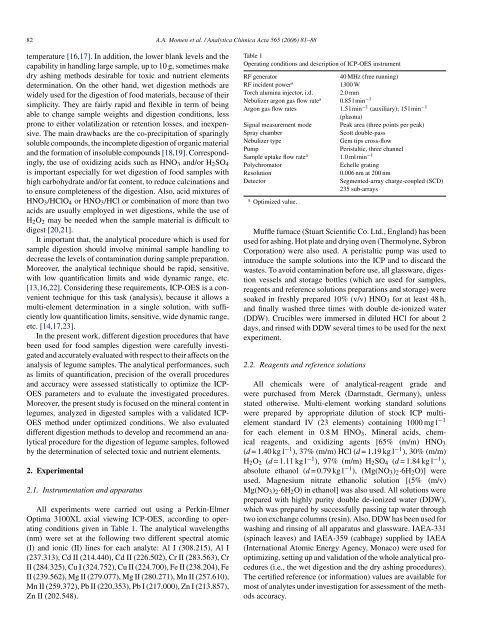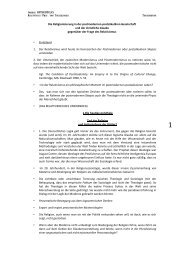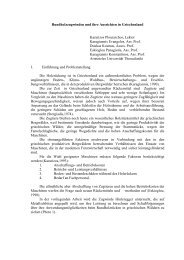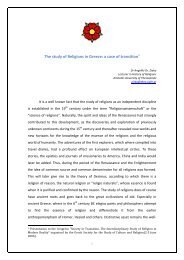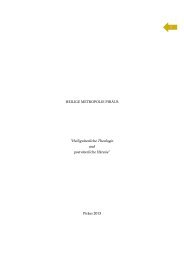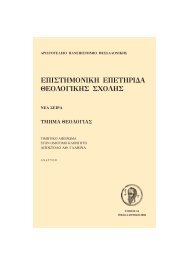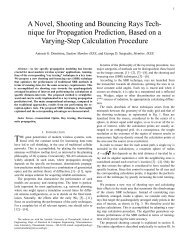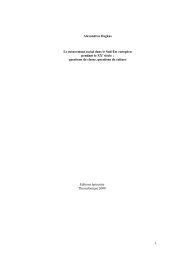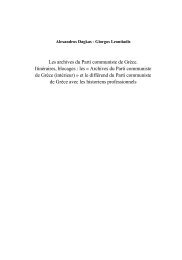Analytica Chimica Acta 565 (2006) 81–88
Analytica Chimica Acta 565 (2006) 81–88
Analytica Chimica Acta 565 (2006) 81–88
Create successful ePaper yourself
Turn your PDF publications into a flip-book with our unique Google optimized e-Paper software.
82 A.A. Momen et al. / <strong>Analytica</strong> <strong>Chimica</strong> <strong>Acta</strong> <strong>565</strong> (<strong>2006</strong>) <strong>81–88</strong><br />
temperature [16,17]. In addition, the lower blank levels and the<br />
capability in handling large sample, up to 10 g, sometimes make<br />
dry ashing methods desirable for toxic and nutrient elements<br />
determination. On the other hand, wet digestion methods are<br />
widely used for the digestion of food materials, because of their<br />
simplicity. They are fairly rapid and flexible in term of being<br />
able to change sample weights and digestion conditions, less<br />
prone to either volatilization or retention losses, and inexpensive.<br />
The main drawbacks are the co-precipitation of sparingly<br />
soluble compounds, the incomplete digestion of organic material<br />
and the formation of insoluble compounds [18,19]. Correspondingly,<br />
the use of oxidizing acids such as HNO 3 and/or H 2 SO 4<br />
is important especially for wet digestion of food samples with<br />
high carbohydrate and/or fat content, to reduce calcinations and<br />
to ensure completeness of the digestion. Also, acid mixtures of<br />
HNO 3 /HClO 4 or HNO 3 /HCl or combination of more than two<br />
acids are usually employed in wet digestions, while the use of<br />
H 2 O 2 may be needed when the sample material is difficult to<br />
digest [20,21].<br />
It important that, the analytical procedure which is used for<br />
sample digestion should involve minimal sample handling to<br />
decrease the levels of contamination during sample preparation.<br />
Moreover, the analytical technique should be rapid, sensitive,<br />
with low quantification limits and wide dynamic range, etc.<br />
[13,16,22]. Considering these requirements, ICP-OES is a convenient<br />
technique for this task (analysis), because it allows a<br />
multi-element determination in a single solution, with sufficiently<br />
low quantification limits, sensitive, wide dynamic range,<br />
etc. [14,17,23].<br />
In the present work, different digestion procedures that have<br />
been used for food samples digestion were carefully investigated<br />
and accurately evaluated with respect to their affects on the<br />
analysis of legume samples. The analytical performances, such<br />
as limits of quantification, precision of the overall procedures<br />
and accuracy were assessed statistically to optimize the ICP-<br />
OES parameters and to evaluate the investigated procedures.<br />
Moreover, the present study is focused on the mineral content in<br />
legumes, analyzed in digested samples with a validated ICP-<br />
OES method under optimized conditions. We also evaluated<br />
different digestion methods to develop and recommend an analytical<br />
procedure for the digestion of legume samples, followed<br />
by the determination of selected toxic and nutrient elements.<br />
2. Experimental<br />
2.1. Instrumentation and apparatus<br />
All experiments were carried out using a Perkin-Elmer<br />
Optima 3100XL axial viewing ICP-OES, according to operating<br />
conditions given in Table 1. The analytical wavelengths<br />
(nm) were set at the following two different spectral atomic<br />
(I) and ionic (II) lines for each analyte: Al I (308.215), Al I<br />
(237.313), Cd II (214.440), Cd II (226.502), Cr II (283.563), Cr<br />
II (284.325), Cu I (324.752), Cu II (224.700), Fe II (238.204), Fe<br />
II (239.562), Mg II (279.077), Mg II (280.271), Mn II (257.610),<br />
Mn II (259.372), Pb II (220.353), Pb I (217.000), Zn I (213.857),<br />
Zn II (202.548).<br />
Table 1<br />
Operating conditions and description of ICP-OES instrument<br />
RF generator<br />
RF incident power a<br />
Torch alumina injector, i.d.<br />
Nebulizer argon gas flow rate a<br />
Argon gas flow rates<br />
Signal measurement mode<br />
Spray chamber<br />
Nebulizer type<br />
Pump<br />
Sample uptake flow rate a<br />
Polychromator<br />
Resolution<br />
Detector<br />
a Optimized value.<br />
40 MHz (free running)<br />
1300 W<br />
2.0 mm<br />
0.85 l min −1<br />
1.5 l min −1 (auxiliary); 15 l min −1<br />
(plasma)<br />
Peak area (three points per peak)<br />
Scott double-pass<br />
Gem tips cross-flow<br />
Peristaltic, three channel<br />
1.0 ml min −1<br />
Echelle grating<br />
0.006 nm at 200 nm<br />
Segmented-array charge-coupled (SCD)<br />
235 sub-arrays<br />
Muffle furnace (Stuart Scientific Co. Ltd., England) has been<br />
used for ashing. Hot plate and drying oven (Thermolyne, Sybron<br />
Corporation) were also used. A peristaltic pump was used to<br />
introduce the sample solutions into the ICP and to discard the<br />
wastes. To avoid contamination before use, all glassware, digestion<br />
vessels and storage bottles (which are used for samples,<br />
reagents and reference solutions preparations and storage) were<br />
soaked in freshly prepared 10% (v/v) HNO 3 for at least 48 h,<br />
and finally washed three times with double de-ionized water<br />
(DDW). Crucibles were immersed in diluted HCl for about 2<br />
days, and rinsed with DDW several times to be used for the next<br />
experiment.<br />
2.2. Reagents and reference solutions<br />
All chemicals were of analytical-reagent grade and<br />
were purchased from Merck (Darmstadt, Germany), unless<br />
stated otherwise. Multi-element working standard solutions<br />
were prepared by appropriate dilution of stock ICP multielement<br />
standard IV (23 elements) containing 1000 mg l −1<br />
for each element in 0.8 M HNO 3 . Mineral acids, chemical<br />
reagents, and oxidizing agents [65% (m/m) HNO 3<br />
(d = 1.40 kg l −1 ), 37% (m/m) HCl (d = 1.19 kg l −1 ), 30% (m/m)<br />
H 2 O 2 (d = 1.11 kg l −1 ), 97% (m/m) H 2 SO 4 (d = 1.84 kg l −1 ),<br />
absolute ethanol (d = 0.79 kg l −1 ), (Mg(NO 3 ) 2·6H 2 O)] were<br />
used. Magnesium nitrate ethanolic solution [(5% (m/v)<br />
Mg(NO 3 ) 2·6H 2 O) in ethanol] was also used. All solutions were<br />
prepared with highly purity double de-ionized water (DDW),<br />
which was prepared by successfully passing tap water through<br />
two ion exchange columns (resin). Also, DDW has been used for<br />
washing and rinsing of all apparatus and glassware. IAEA-331<br />
(spinach leaves) and IAEA-359 (cabbage) supplied by IAEA<br />
(International Atomic Energy Agency, Monaco) were used for<br />
optimizing, setting up and validation of the whole analytical procedures<br />
(i.e., the wet digestion and the dry ashing procedures).<br />
The certified reference (or information) values are available for<br />
most of analytes under investigation for assessment of the methods<br />
accuracy.


